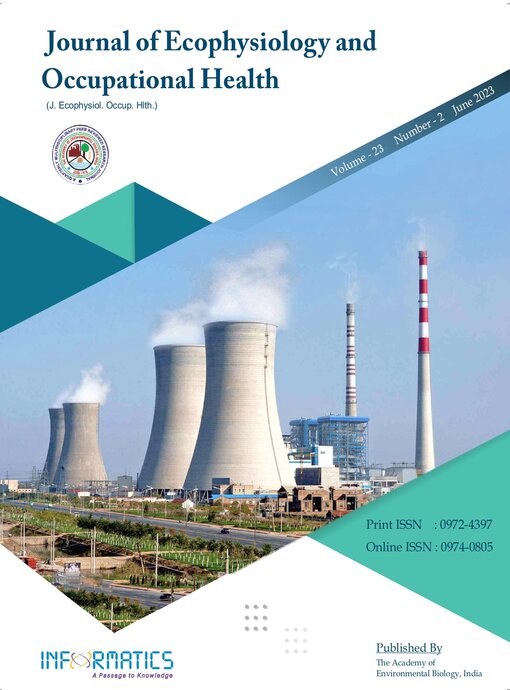Ground Water Arsenic Causes Premature Senescence in Population from Gangetic Basin, India
DOI:
https://doi.org/10.18311/jeoh/2023/33520Keywords:
Arsenic, SA-beta-Gal, Senescence, Telomere, Terminal Restriction FragmentAbstract
Groundwater arsenic is the main public health concern in the Indo-Bangladesh Gangetic basin. Much work has been done on the carcinogenic effect of arsenic. Compared to that other cellular effects, cellular senescence in the human system was not studied. Replicative senescence that occurs by the gradual shortening of telomeres, and other cellular changes, is characteristic of human somatic cells. Premature senescence, characterized by increased beta-galactosidase activity; abnormal decrease in telomere length may also be the effect of arsenic. The objective of this study was to know whether premature senescence in the human cellular system can be induced by arsenic. Human cases were selected from the arsenic-affected district (Murshidabad), and controls were taken from the unaffected district (East Midnapore) of West Bengal. Senescence-associated beta-galactosidase in cell and telomere length measured by Southern blotting by DIG-labelled chemiluminescence method was conducted. The result indicated that arsenic causes premature cellular senescence in the human system.
Downloads
Metrics
Downloads
Published
How to Cite
Issue
Section
License
Copyright (c) 2023 Sujata De Chaudhuri

This work is licensed under a Creative Commons Attribution 4.0 International License.
Accepted 2023-06-16
Published 2023-06-16
References
Agency for Toxic Substances and Disease Registry. Atlanta (ATSDR). Toxicological profile for arsenic; 2021. Available at: https://www.atsdr.cdc.gov/.
US EPA. Basic information about arsenic in drinking water; 2023. Available at: http://water.epa.gov/drink/contaminants/index.cfm
Sujata De Chaudhuri, Manjari Kundu, Mayukh Banerjee, Jayanta K. Das, Papiya Majumdar, Santanu Basu, et al. Arsenic-induced health effects and genetic damage in keratotic individuals: Involvement of p53 arginine variant and chromosomal aberrations in arsenic susceptibility. Mutat Res. 2008; 659(1-2):118–25. https://doi.org/10.1016/j.mrrev.2007.11.008 DOI: https://doi.org/10.1016/j.mrrev.2007.11.008
Liu L, Trimarchi JR, Navarro P, Blasco MA, Keefe DL. Oxidative stress contributes to arsenic-induced telomere attrition, chromosome instability, and apoptosis. J Biol Chem. 2003; 278(34):31998–32004. https://doi.org/10.1074/jbc.M303553200 DOI: https://doi.org/10.1074/jbc.M303553200
Kurz DJ, Decary S, Hong , Erusalimsky JD. Senescence-associated beta-galactosidase reflects an increase in lysosomal mass during replicative ageing of human endothelial cells.. J Cell Sci. 2000; 113:3613–22. https://doi.org/10.1242/jcs.113.20.3613 DOI: https://doi.org/10.1242/jcs.113.20.3613
Zhang TC, Schmitt MT, Mumford JM. Effects of arsenic on telomerase and telomeres in relation to cell proliferatio and apoptosis in human keratinocytes and leukemia cells in vitro. Carcinogenesis. 2003; (24):1811–17. https://doi.org/10.1093/carcin/ bgg141 DOI: https://doi.org/10.1093/carcin/bgg141
Zhang Y, Cao EH, Liang XQ, Qin JF. Increasing sensitivity to arsenic trioxide-induced apoptosis by altered telomere state. Eur J Pharmacol. 2003; 474(2-3):141–7. https://doi.org/10.1016/ S0014-2999(03)02013-2 DOI: https://doi.org/10.1016/S0014-2999(03)02013-2
Choi J, Shendrik I, Peacocke M, Peehl D, Buttyan R, Ikeguchi EF, et al. Expression of senescence-associated beta-galactosidase in enlarged prostate from men with benign Prostatic hyperplasia. Urologia. 2000;160–6. https://doi.org/10.1016/ S0090-4295(00)00538-0 DOI: https://doi.org/10.1016/S0090-4295(00)00538-0
Sambrook J, Fritsch EF, Maniatis T. Molecular cloning: A laboratory manual, 2nd edition. Cold Spring harbor, NY: Cold Spring Harbor Laboratory; 1989.
 Sujata De Chaudhuri
Sujata De Chaudhuri








